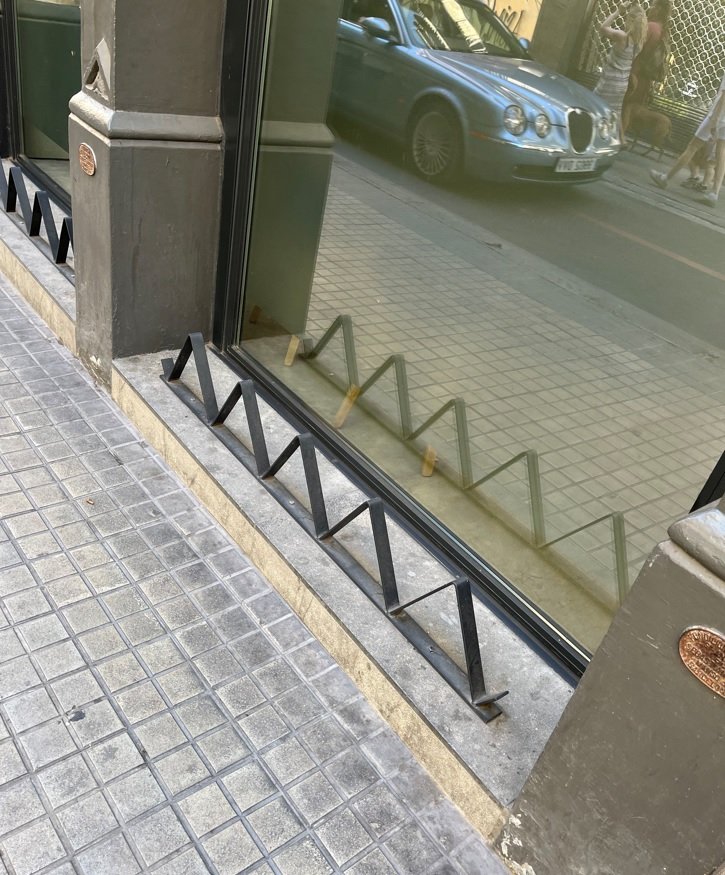Written by Taylor Hoying
Public spaces are places that are generally believed to be accessible to everyone for a variety of purposes. Despite this, architecture and design have been used to discourage certain activities and exclude certain people since the 19th century. Awareness of hostile architecture has been on the rise recently, largely due a controversy in London in 2014, where metal spikes were installed to discourage homeless people from sleeping in flat areas. Concerned citizens have taken to social media to share photos of hostile architecture in their cities.
Picture taken by Juan González Iglesias in Madrid.
“It keeps the uncomfortable truth away from general viewing and makes for plausible deniability so they can play down the severity of the homeless situation.”
Although these small aspects of our cities may not make a large impression on the everyday person, they have a large impact on the homeless community. Imagine coming home at night and finding that someone has replaced your bed with metal spikes. While perhaps unfathomable to most people, this is the unfortunate reality for many people who are homeless. I spoke with Homeless Entrepreneur Ramón Feiner about his experience with hostile architecture.
“This kind of architecture is a big problem, because it is a way that society shows that they don’t accept or want you, and it makes you feel sad and alone. Nowadays it is very difficult to find a place to sleep after a hard day.”
Hostile architecture is defined as “architecture used to guide or restrict behavior in urban space as a form of crime prevention or protection of property” (Chellew, 2019). While this alone may not sound like a bad thing, this type of design disproportionately affects the people who rely on public spaces the most, such as people who are homeless. Unfortunately, not every example of hostile architecture is overtly negative and obvious to the public.
Picture taken by Taylor Hoying in Barcelona.
When walking past a bench with arm rests throughout the center, your first thought is likely not how it is now impossible for someone to lay down. Similarly, when looking underneath a highway overpass, seeing rocks or concrete slabs likely does not cause you to think about those who can no longer access a dry place in the rain. These subtle installations largely fly under the radar, unless someone calls attention to them.
“In Barcelona, the chairs and benches made specifically against people sleeping on it…… Seen it in NY and London too…. That’s not how you fight homelessness.”
Picture taken by Taylor Hoying in Barcelona.
Conversely, some examples of hostile architecture are so obvious as to leave no doubt about their true purpose. Metal spikes tend to attract attention, as do metal bars intended to block access to dry areas. Although these explicit examples do receive more backlash, they remain in cities, and continue to make life harder for people already experiencing more difficulty than many of us can imagine. During a conversation about hostile architecture, artist Juan González Iglesias described the installations in his area.
“Around my hood, there are some KILLER STRUCTURES. It feels just evil, soulless. Vertical spikes, with no other purpose. Black and horrible, they look clearly nasty.”
To see firsthand how many installations I could find in my own city, I took a walk around Barcelona. Within 10 minutes, I found 4 windowsills that were full of metal bars. To see if there was a way to still make the space usable, I attempted to relax there for a moment. I found that it was exceedingly uncomfortable to even stand on the ledge, let alone lay or sit down.
Hostile architecture does not only take the form of additions to public spaces; it can also manifest in the form of removal. By removing the backs of public seating or benches, design encourages people not to linger, and by extension, removes yet another place for the homeless to sleep. By simply not including bathrooms or benches in public spaces, the space becomes accessible only to those who have somewhere else to go.
It is easy for a person to ignore problems that do not personally affect them, but the installation of hostile architecture is something that everyone should be concerned about, because everyone is affected. This concept is easily demonstrated by taking a walk down Las Ramblas in Barcelona. From La Boqueria all the way down to the beach, there is not a single bench or unadorned windowsill. Excluding the restaurants, there is not a single place to sit and enjoy the city. The removal of public seating might encourage the homeless not to linger in a popular tourist area, but it also causes the patrons of the shops to pass through quickly.
“It affects people who are not homeless since everybody has the need at some point to sit and relex.”
Homeless Entrepreneur works to end homelessness through economic empowerment and provide support for those who want to improve their lives, but do not have the resources to do so. Through initiatives such as The Launchpad Housing Program and the HELP Program, Homeless Entrepreneur helps create opportunities for housing and economic growth. While these processes have the goal of getting homeless people off the streets and into stable housing, it is important to also consider their quality of life while they are still sleeping rough. Hostile architecture is appropriately nicknamed anti-homeless architecture. By cutting down the already limited options available to homeless people, we further isolate those that we should be attempting to bring closer.











